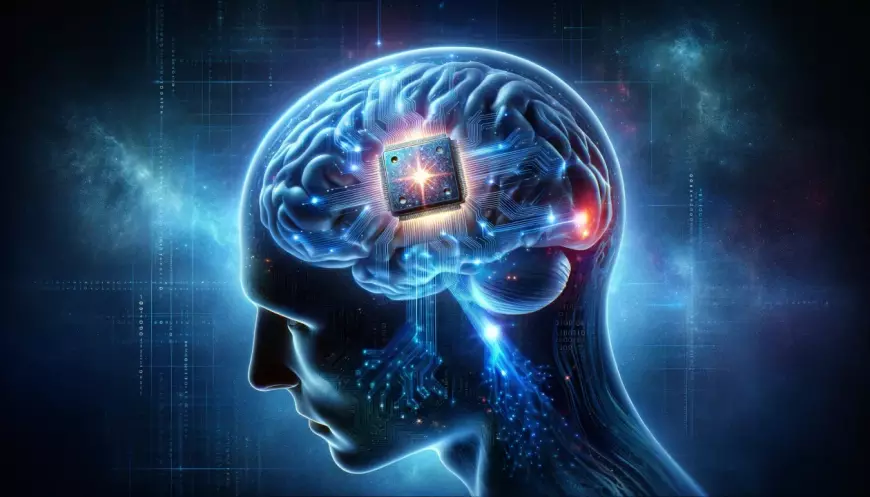What is Neuralink? Everything to know about first brain implant
Neuralink, founded by Elon Musk, is a neurotechnology company working on brain-machine interface technology to merge humans with AI.

Neuralink, established by Elon Musk, is a neurotechnology firm developing an implantable brain-computer interface to interpret thoughts into actions. Founded in 2016, the private venture asserts that its neural device can enable individuals with paraplegia to regain mobility and restore vision for those blind since birth.
Neuralink, established by Elon Musk in 2016, is creating a brain-computer interface known as "the Link." This neural-chip implant, surgically embedded, aims to decipher and stimulate brain activity.
In January 2024, Neuralink successfully implanted its inaugural device into a patient's brain. The individual, paralyzed below the shoulders, utilized the Neuralink device to play chess on a laptop.
What is Neuralink?
Neuralink, a technology company, is crafting a device aimed at establishing direct connections between human brains and computers, as stated by Ramses Alcaide, CEO of Neurable. While Neurable develops non-invasive brain-computer interfaces in the form of headphones, Neuralink's technology can record and interpret neural signals, transmitting information back to the brain through electrical stimulation.
Termed "the Link," this implant, the size of a coin, is surgically inserted beneath the skull. It gathers information from neural threads extending into various brain regions controlling motor functions. These threads feature sensors capable of recording and emitting delicate electrical currents, too intricate for manual insertion, as per Neuralink's website. Hence, Neuralink has engineered a neurosurgical robot slated for full automation.
Additionally, Neuralink is designing an app enabling individuals to control a keyboard and mouse solely with their thoughts.
"Neuralink is leading the way in commercializing and scaling up what has been pioneered in academia," remarked Sumner Norman, a scientist at Convergent Research. He added, "Decades of academic research have pushed this field to its limits, but ultimately, its development becomes financially daunting."
How does Neuralink work?
Neuralink's foundational technology operates akin to electrophysiology, elucidated Norman. The nervous system's electrical-chemical signals ignite as neurons communicate across synapses, gaps between nerve cells. Electrodes, or voltage-detecting sensors, capture this brain activity, measuring voltage spikes or potential firings.
In essence, the data on our brain activity is not only captured during action but also when contemplating it.
However, this brain-computer interface isn't synonymous with mind-reading, clarifies Baberwal, a researcher at Dublin City University. Instead, it interprets brain activity as an action, likening it to how blood pressure gauges stress levels.
"Similar to blood pressure indicating stress or relaxation levels, brain signals can detect various states such as eyes closed or open, relaxation, deep sleep, action, or focus," she elucidated.
Given the intricate datasets these devices record, machine learning algorithms and other artificial intelligence tools are deployed to decipher the information.
What are the functions of Neuralink?
As per Neuralink's website, the company's primary objective is to assist individuals immobilized by paralysis in reclaiming communication abilities. Future endeavors aim to focus on reinstating motor, sensory, and visual functions, along with addressing neurological disorders.
Alcaide highlighted the potential of a Neuralink-like device to enhance human memory, processing speed, and cognitive abilities by establishing a direct interface between the human brain and digital devices.
Treat neurological conditions
Brain-computer interfaces can identify alterations in brain activity indicative of various neurological conditions such as epilepsy, bipolar disorder, obsessive-compulsive disorder, Alzheimer’s, or Parkinson’s disease, noted Alcaide.
Furthermore, they have the potential to monitor symptoms related to mental health. Norman highlighted the possibility of administering electrical stimulation to specific brain regions as a treatment for burnout, fatigue, anxiety, and depression. Unlike motor skills, which are localized, these conditions are dispersed across the brain.
Norman, who has devoted a decade to developing brain-computer interfaces and neuroprosthetics for individuals with neurological injuries or diseases, emphasized the potential to ameliorate paralysis, neurological disorders, and injuries. He believes that this advancement could significantly improve mental health outcomes, reducing the prevalence of untreatable depression or anxiety and restoring agency to those who have lost it.
Restore mobility
According to Alcaide, brain-computer interfaces have the potential to operate prosthetics or exoskeletons. This application would allow individuals with paralysis or amputations to regain a degree of mobility and autonomy.
Improve communication for Non-verbal individuals
Neuralink's primary objective is to aid individuals who cannot speak or write in communicating with others. This is achieved by enabling them to control a virtual mouse, keyboard, or send messages through their thoughts. For instance, individuals with paraplegia could utilize speech or text synthesis to navigate the internet and engage in digital art creation using a computer or mobile device.
Enhance cognitive abilities
This technology also has the potential to enhance individuals' focus, memory, and attention by enabling them to train their brain using real-time biofeedback and other methodologies. Describing it as a "Fitbit in your skull," Musk envisions the Link equipped with all the sensors typically found in a smartwatch.
"We don't know what we would do with all the data if suddenly we could sense every neuron in the human brain simultaneously," remarked Norman. With approximately 80 billion neurons and around 1,000 synapses between them, interpreting such vast data remains a challenge.
Norman highlighted that Neuralink's current technology can detect up to 10,000 of these connections, a significant advancement from the hundreds observed in academic trials.











































